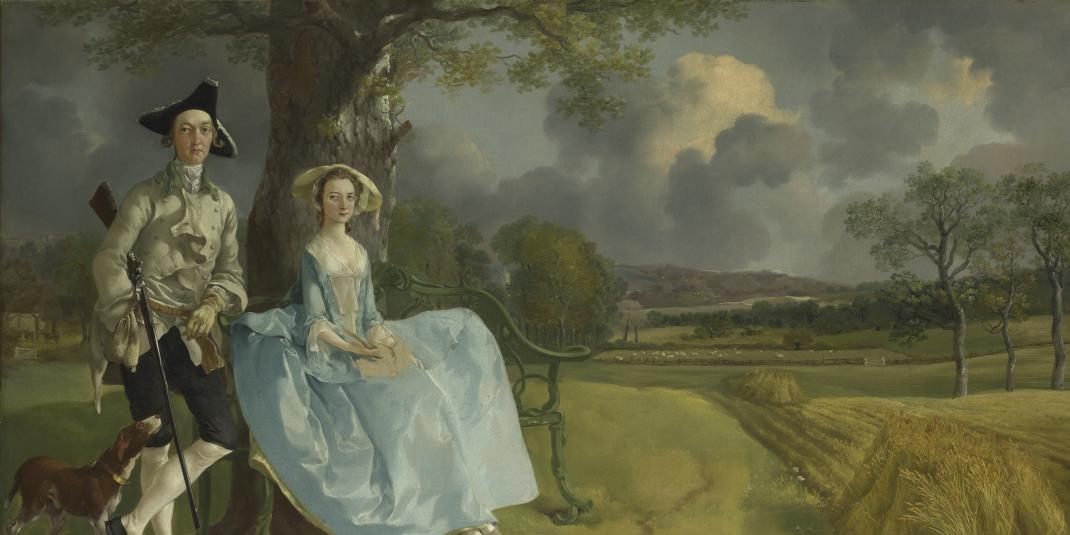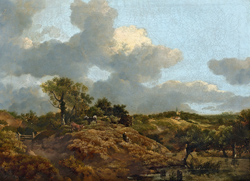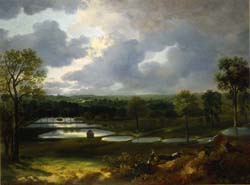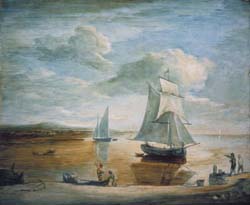
Contents
Thomas Gainsborough
In the spring of 2018 the Hamburger Kunsthalle is mounting Germany's first large-scale monographic exhibition on the English painter Thomas Gainsborough (1727–1788), concentrating on his role as a pioneer of ›modern‹ landscape painting. Curated by the director of the Hamburger Kunsthalle, Christoph Martin Vogtherr, the show features some 80 exhibits, comprising around 40 paintings and 40 works on paper.
Thomas Gainsborough, born in Sudbury, grew up in Suffolk in south-eastern England, and the landscape there would leave a lasting mark on his art. He trained with French-influenced artists in London and undertook close studies of Netherlandish landscape painting. His art thus springs from a broad grounding in European art. Gainsborough experienced his breakthrough after moving to the fahionable spa town of Bath, where he became highly successful as a society portraitist. He later worked in London and was a founding member of the Royal Academy.
Gainsborough much preferred painting landscapes to portraits. They provided a far better field for experimentation with highly innovative media and techniques, allowing him to continuously to develop his style. The artist picked up on the wave of experimentation that swept England in the eighteenth century, eventually elevating it to the standing of Europe’s leading economic and political force. At the same time, Gainsborough's contribution helped to transform his country into a prime European centre for art.
The exhibition will feature works from leading collections in the UK, including the National Gallery, the Tate Gallery and the Victoria and Albert Museum in London as well as the Barber Institute in Birmingham, and also by the Staatliche Museen zu Berlin, the Bayerische Staatsgemäldesammlungen Munich and by private collections in Germany and the UK. The works on view include icons of British painting, such as Mr and Mrs Andrews and The Watering Place, which count among the most famous paintings of all time in the English-speaking world.
The exhibition builds on a long Hamburger Kunsthalle tradition of highlighting the era of major transformation around 1800 as the beginning of modernity in art, a tradition that began with the legendary cycle Art around 1800 launched by former director Werner Hofmann. As a complement to German Romanticism, which is well-represented in the Kunsthalle’s collection, and the French art of the period, the Gainsborough show thus presents England as a further centre of European landscape painting.
A richly illustrated scholarly catalogue with contributions by Christoph Martin Vogtherr, Bettina Gockel, Rica Jones, Mark Hallet, Mark Bills and others accompanies the exhibition, available in both German and English (Hirmer Verlag, Munich). The catalogue can be purchased in the Museum Shop for 29 euros or ordered online at www.freunde-der-kunsthalle.de.
A multimedia guide is available in German and English. For the dates of guided tours and further information on the exhibition, visit www.hamburger-kunsthalle.de.
The exhibition has been organised in close cooperation with Gainsborough’s House in Sudbury.
Supported by: Ministry of Culture and Media, Hamburg, Freunde der Kunsthalle e. V. and Paul Mellon Centre for Studies in British Art
Media Partner: Hamburger Abendblatt Culture Partner: NDR Kultur
Exhibition Topics
»The Modern Landscape« organises the presentation of Gainsborough’s landscape scenes into three chapters.
Netherland Role Models
Thomas Gainsborough’s early paintings clearly betray the influence of Netherlandish landscape painting of the seventeenth century. The Dutch painters were highly admired at the time, and Gainsborough was able to study their works in many private collections. He did not visit the Netherlands until late in his life. The young painter started out by emulating the everyday subjects and seemingly simple compositions of his Dutch colleagues. Their example helped him to hone his skills at a time when English contemporary painting was often still quite
provincial. Gainsborough managed in this way to achieve great clarity and depth in his landscapes. The paintings capture atmospheres and compellingly evoke specific moods. Even though the scenes are largely imaginary, they suggest harmony and the direct observation from nature.

Thomas Gainsborough (1727–1788),:Landschaft mit Hirten, um 1746/47 Öl auf Leinwand, 49 x 65,5 cm ,Sudbury, Gainsborough`s House Society
Rendering Reality
Under the theme Rendering Reality, the exhibition compares and contrasts early works by Gainsborough such as Holywells Park with Netherlandish landscapes from the collection of the Hamburger Kunsthalle. This juxtaposition demonstrates how the artist learnt a great deal about composition, perspective and atmospheric representation from his Netherlandish colleagues, leading him to value landscape as a conveyer of mood. Like other English artists of the early eighteenth century, Gainsborough followed the European tradition closely and yet used it as a springboard for developing his own novel style. He was particularly interested in how humans relate to the landscape around them, in their close connection with and empathetic experience of nature, which found expression in the concept of the “sensibility”.

Thomas Gainsborough (1727–1788): Holywells Park, um 1748–1750, Öl auf Leinwand, 50,8 x 66 cm, Ipswich Museum and Gallery © Ipswich Museum and Gallery
The Social Landscape
The second chapter on The Social Landscape highlights how Gainsborough’s landscape art subtly reflected the major social upheavals of his day. What at first glance seem like bucolic scenes betray upon closer inspection signs of poverty and despair as the artist attempts in each picture to convey a subject and a new rendering for which no clear-cut formula had yet been invented. The increasing privatisation of common agricultural land during Gainsborough’s lifetime deprived large parts of England’s rural population of their livelihood, forcing peasants to migrate to the cities and hire themselves out as cheap labour. In a simultaneous development, ownership of large estates became a status symbol. Gainsborough addressed these trends from both the point of view of the propertied class and that of the newly impoverished. The rural exodus would become a central theme in his late landscapes, such as his masterpiece The Harvest Wagon.

Thomas Gainsborough (1727–1788): Waldlandschaft mit Wagen (»Der Erntewagen«), um 1766, Öl auf Leinwand, 120,7 x 144,8 cm, Birmingham, The Barber Institute of Fine Arts © The Barber Institute of Fine Arts, Birmingham
The Creative Process
Technical advances during this era, chief among them the development of the steam engine and the invention of the mechanical loom, laid the groundwork for early industrialisation. The exhibition illustrates in the third chapter on The Creative Process how the ideal of innovation equally prevailed in English painting. Gainsborough’s landscape art became a kind of technological and intellectual laboratory: in an effort to achieve the desired effects in his drawings and to continually push the boundaries of the genre, he experimented with different media and techniques such as aquatint and soft-ground etching and even used skim milk washes or painted images on glass. One of these highly fragile paintings on glass is featured in the exhibition, Coastal Landscape with Sailing Ships. Originally presented in a kind of peep-show box the artist had constructed, in the exhibition the painting is lit from behind to recreate this experience.

Thomas Gainsborough (1727–1788): Küstenlandschaft mit Segelschiffen, um 1783, Öl auf Glas, 27,9 x 33,7 cm, London, Victoria and Albert Museum © Victoria and Albert Museum, London
To Painting’s Limits
Gainsborough’s late works demonstrate just how radically he went about making light and colour the point of departure for his paintings. The mood and atmosphere of the scenes have now become the main subject. The figures can no longer be clearly distinguished from their surroundings. Individual outlines seem to dissolve. At »The Marsham Children« Gainsborough’s brush strokes are, in parts, so free and dynamic, that the borders of some pictorial elements
These paintings demonstrate a special quality: the painter’s brushstrokes can be seen clearly from up close, but when stepping back from the picture they meld to create a coherent image. Gainsborough had very precise ideas about the ideal height at which his works were to be hung in the galleries of the Royal Academy. In trying to guarantee that his pictures could unfold their optimal effect, he frequently got into arguments with the organisers of Academy exhibitions. Drawing on art historical traditions, Gainsborough developed a new aesthetic, one that would prove seminal for subsequent generations of artists.
Thomas Gainsborough (1727-1788): Amelia Charlotte, Frances, Harriot und Charles Marsham (»Die Marsham-Kinder«), 1787, Öl auf Leinwand, 242,9 x 181,9 cm, Staatliche Museen zu Berlin, Gemäldegalerie © bpk/Gemäldegalerie, SMB /Jörg P. Anders
Audioguide
| Description | Audio |
|---|---|
| Wooden Landscape with Cottage on a Pond, before 1782 | |
| Coastal Landscape with Sailing Ships, c. 1783 | |
| Mountainous Landscape with Shepherds and Sheep, 1783 |
For the exhibition »Thomas Gainsborough. The Modern Landscape « linon conceived and produced the audio guide. Available for 3 € in the Foyer of the Hamburger Kunsthalle.







